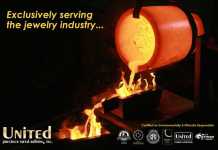
A DIAMOND IN THE ROUGH
When it comes to the world’s foremost authority on diamonds, coloured stones, and pearls, GIA is definitely the name that comes to mind first.
Established in 1931, GIA (Gemological Institute of America) is a nonprofit institute that has led the way as the go-to source for knowledge, standards, and education concerning gems and jewellery.
Not only did the company establish the widely used 4Cs and the International Diamond Grading System™ in the 1950s, GIA also offers top quality education courses for students around the world who are interested in gemmology and jewellery design.
A valuable member
We spoke with Bev Hori, GIA’s chief learning officer and vice president of education, to learn more about GIA’s latest developments, new initiatives, and the Institute’s relationship with the Canadian market.
“Canada is an important consumer market in the gem and jewellery industry,” says Hori. “And it’s a source of diamonds.” At the moment, GIA has active alumni chapters in regions throughout the country, including Ontario, Quebec and British Columbia. And most recently, a secondary diamond industry with cutting and polishing plants has even been set up in the Northwest Territories.
When it comes to her role at GIA, Hori actually worked as an instructor for the Institute earlier in her career and returned to the Institute in 2010 to head its global education efforts. Prior to rejoining GIA, Hori spent nine years with the Seattle-based Ben Bridge Jewelers, most recently as vice president of education. There, she developed the Ben Bridge Knowledge Center and a learning management system with e-tools to train sales associates at more than 70 stores in 12 states. She was also involved in corporate social responsibility initiatives and served on the board of directors for a number of industry organizations. Coming back to GIA, she brought along with her a massive amount of new knowledge and expertise in the industry.
“I enjoy working with students and staff from around the world who have a common passion for discovering the world inside gems and for the art of jewellery design and manufacturing,” she says. “At GIA, you really get a sense that people feel fulfilled by their work and are driven by our mission of serving the public. I also am lucky in that I meet and work with a diverse range of people each day, and face a new set of challenges and discoveries.”
Today, GIA is responsible for protecting the public’s trust in the global gem and jewellery industry by serving as an unbiased, third-party evaluator of gemstone quality says Hori.
“[GIA] helps ensure consumer trust in the industry, which in turn, benefits the trade,” she adds. “Throughout its 83-year history, the Institute’s mission to ensure the public trust in gems and jewellery has remained at the center of all its activities.”
Educational efforts
While the Institute may hold a reputation of being one of the best educators in the global gems and jewellery industry, this status was a result of GIA’s efforts in observing the needs of its consumers.
Over the past year, Hori says the Institute has continued to dedicate itself to further its mission of educating the public about the industry. These efforts include revamping the company’s website, which now allows both consumers and members of the trade to easily access information ranging from basic diamond buying tips to in-depth articles from Gems & Gemology, GIA’s peer-reviewed quarterly scientific journal.
Another development includes GemKids, an interactive site geared toward students ages nine to 12. The site aims to help the children learn about gemmology and geology in a fun and engaging way, according to Hori.
Global reach
Apart from the digital world, GIA’s recent developments also include expanded beneficiation efforts on an international level. This comes as no surprise since the company employs more than 2,000 people throughout the world.
Most recently, GIA made its mark in Africa as part of the seventh annual Africa Education Week in Johannesburg. The Institute introduced more than 1,000 African students to gem and jewellery education opportunities at the Career Indaba trade show.
In addition to this, Hori says that GIA signed a Memo of Understanding (MoU) with The Nelson Mandela Centre of Memory at the Nelson Mandela Foundation to provide four elementary schools in South Africa with Mandela Day Libraries; two were dedicated in February. The focus behind this initiative is to bridge the gap in literacy and reading proficiency throughout schools in Africa.
Future initiatives
Moving forward, the GIA team shows no sign of slowing down, especially when it comes to its mission of ensuring the public trust in gems and
jewellery. Hori says that some of the plans in the near future include further development of GIA’s Jewelry Career Fairs around the world, expanded
education offerings and a continued focus on gemmological research.
This year, the Institute will join the heart of New York’s diamond district by relocating its laboratory and campus to the International Gem Tower on 47th Street. The laboratory in Mumbai is also under expansion, with plans to double its facilities and hire more staff to meet the growing demand for lab services.
One thing is for sure, and that is the fact that GIA owes much of its success to the people that stand behind the name.
“Our staff’s and students’ passion for gems and jewellery is evident as you walk through the Institute’s hallways each and every day,” says Hori. “From our researchers to our instructors to our museum curators, GIA’s staff devotes themselves to their work in a way that is both inspiring and appreciated.” CJ

















